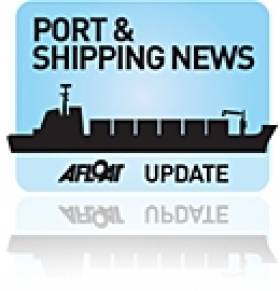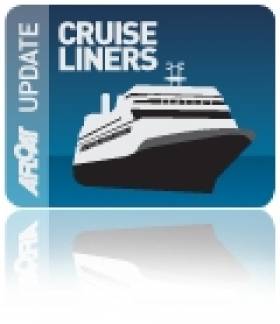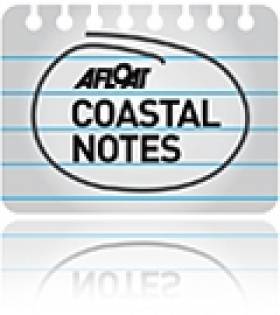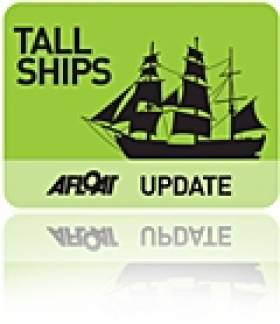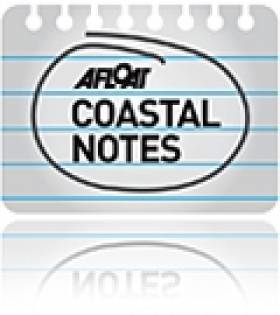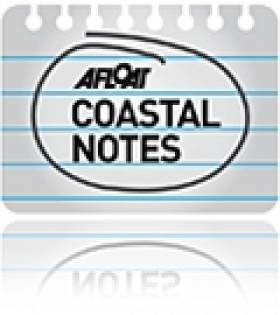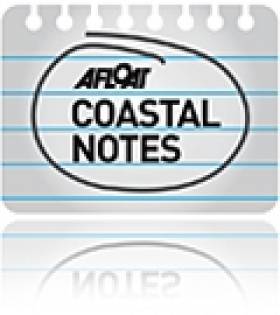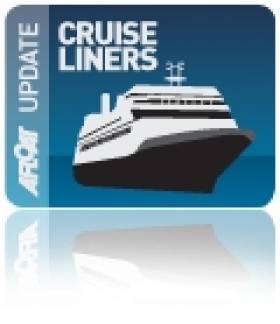Displaying items by tag: Dun Laoghaire Harbour
Tanks for Guinness Arrive in Dun Laoghaire Harbour
#DunLaoghaire – Last night the Dutch-flagged Myrte (6,120 tonnes) docked in Dun Laoghaire Harbour loaded with fermentation tanks bound for Guinness, writes Jehan Ashmore.
The 10 X 30 tons fermentation tanks are to be discharged during the week and installed in Diageo's Guinness (St. James Gate) plant. The historic city-centre brewery's fermentation plant is to be refurbished as part of a major investment.
The 122m cargoship berthed alongside the former conventional ferry (mail) boat Carlisle Pier, from where the cargo will be taken by road convoy, but travelling overnight to avoid traffic and minimise disruption.
This delivery is part of a 'project' cargo as a further two shipments are scheduled, however it has been many years since cargoships have called to Dun Laoghaire Harbour.
In the late 1980's/early 90's there were relatively frequent calls undertaken by 'reefer' ships, vessels equipped with refrigeration capability carrying perishable products.
Some vessels were instead of the ro-ro design, this allowed refrigerated freight-trailers to be driven onboard the ship which berthed at the port's ferry ramp linkspan.
Ten Cruise Liners Due for Dun Laoghaire Harbour, including Queen Mary II
##cruiseliner – 10 cruise ships are expected in Dún Laoghaire in 2013 bringing an esitmated 10,000 visitors to the east coast town according to Dun Laoghaire Harbour Company. The world famous Queen Mary II will be one of the first arrivals in to Dublin Bay and Dún Laoghaire on May 16th 2013. Cunard Line's flagship Queen Mary 2 previously docked at Cobh in 2011. The 148,528 tonnes giant liner cost €549m and she is the only true 'liner' operating in the world today as she on occasions provides scheduled trans-Atlantic sailings between Southampton and New York. More on the Queen Mary II.
Take a Stroll with a Dún Laoghaire Seafront Memorial Tour
#SEAFRONT TOURS – Take in the sea-air while getting to know some historical landmarks, along Dun Laoghaire Harbour's waterfront with the Seafront Memorials Tour. The free guided tour runs every Saturday morning until the 1 September.
The tours take in all the coastal memorials to include the Queen Victoria Fountain, George IV Memorial, the mailboat R.M.S. Leinster's anchor, the Crimean War Cannon and the 1895 Lifeboat Disaster.
The tours start at 11.30 am (1 tour on each Saturday) and they take approximately 1 hour. The maximum number of people for each tour is 20 persons, noting the outdoor event is also wheelchair accessible. No pre-booking is required and places are limited so it is advisable to turn up early.
The tours are part of the 'Summer of Heritage' programme which is now in its fifth year organised by Dun Laoghaire-Rathdown County Council. For information call: (01) 254 2387 or visit: www.dlrevents.ie/heritage.html
Bad Weather Forces Tallship to Abandon Final Race Leg
#TALL SHIPS – The first of the Tall Ships has arrived, the barque STS Pogoria, an A-class tallship which berthed in Dun Loaghaire Harbour this afternoon, albeit earlier than expected due to bad weather, writes Jehan Ashmore.
The steel hulled 49m long vessel encountered bad weather in the Bay of Biscay, while taking part in the final race leg from Coruna, where on Thursday night, as previously reported on Afloat.ie, the official finishing line was off Tuskar Rock.
She made her entrance to Dublin Bay, albeit without setting sail and as she motored passed the Kish Lighthouse, she set a course for the South Burford buoy near Dalkey Island. She then headed for Dun Laoghaire rather then Dublin, from where a pilot cutter departed to board the vessel.
STS Pogoria was built for the Steel Workers Union in 1980 and her current status as 'flagship' of The Sail Training Association which is based in Gdansk, and from where she was built. She has a crew of 11 officers and a trainee crew of around 40 personnel.
Over the next few days the fleet of tallships numbering more than 40 vessels, are to arrive in Dublin Port. The next caller is expected to be the Ecuadorian Navy's sail-training ship Guayas with an ETA of 18.00hrs today. The tallship is also rigged as a barque, yet she is considerably larger, measuring nearly 80m in length and a crew complement of 112 officers and 63 trainees.
Take a stroll along Dún Laoghaire with the Seafront Memorials Tour
#SEAFRONT TOURS – Now that the bad weather that covered half of the country is behind us, the forecast at least for Dublin and next Saturday is more promising. So why not consider taking a stroll with the sea-air along the waterfront in Dun Laoghaire Harbour and learn some local history by taking a Seafront Memorials Tour. The free guided tour runs every Saturday morning until the 1 September.
The tours take in all the coastal memorials along the harbour's waterfront including the Queen Victoria Fountain, George IV Memorial, the mailboat R.M.S. Leinster's anchor, the Crimean War Cannon and the 1895 Lifeboat Disaster.
The tours start at 11.30 am (1 tour on each Saturday) and they take approximately 1 hour. The maximum number of people for each tour is 20 persons, noting the outdoor event is also wheelchair accessible. No pre-booking is required and places are limited so it is advisable to turn up early.
The tours are part of the 'Summer of Heritage' programme which is now in its fifth year organised by Dun Laoghaire-Rathdown County Council. For information call: (01) 254 2387 or visit: www.dlrevents.ie/heritage.html
Dún Laoghaire Seafront Memorials Tour
#SEAFRONT TOURS – With glorious weather hopefully holding, seize the opportunity by taking the sea-air and learn at the same time. Sounds like a good combination, so why not consider joining the Seafront Memorials Tour which is a guided tour in Dun Laoghaire Harbour running every Saturday morning until the 1 September.
The tours take in all the coastal memorials along the harbour's waterfront including the Queen Victoria Fountain, George IV Memorial, the mailboat R.M.S. Leinster's anchor, the Crimean War Cannon and the 1895 Lifeboat Disaster.
The tours start at 11.30 am (1 tour on each Saturday) and they take approximately 1 hour. The maximum number of people for each tour is 20 persons, noting the outdoor event is also wheelchair accessible. No pre-booking is required and places are limited so it is advisable to turn up early.
The tours are part of the 'Summer of Heritage' programme which is now in its fifth year organised by Dun Laoghaire-Rathdown County Council. For information call: (01) 254 2387 or visit: www.dlrevents.ie/heritage.html
Dún Laoghaire Seafront Memorials Tour
#SEAFRONT TOURS – Another weekend and a chance to take in the fresh sea-air while learning at the same time. Sounds like a good combination, so why not consider joining the Seafront Memorials Tour which is a guided tour in Dun Laoghaire Harbour which runs every Saturday morning until the 1 September.
The tours take in all the coastal memorials along the harbour's waterfront including the Queen Victoria Fountain, George IV Memorial, the mailboat R.M.S. Leinster's anchor, the Crimean War Cannon and the 1895 Lifeboat Disaster.
The tours start at 11.30 am (1 tour on each Saturday) and they take approximately 1 hour. The maximum number of people for each tour is 20 persons, noting the outdoor event is also wheelchair accessible. No pre-booking is required and places are limited so it is advisable to turn up early.
The tours are part of the 'Summer of Heritage' programme which is now in its fifth year organised by Dun Laoghaire-Rathdown County Council. For information call: (01) 254 2387 or visit: www.dlrevents.ie/heritage.html
#MARINE RESEARCH YACHT– The 36m French marine biology research yacht Tara, skippered by Loic Valette, sailed under motor-power into Dun Laoghaire Harbour from Lorient this afternoon, writes Jehan Ashmore.
The two-master is operated by Tara Expeditions which is a non-profit organisation which aims to learn more about the impact of climate change on ecosystems. She has travelled extensively on expeditions to both poles and throughout the world and where the organsiation have collected samples and data to the scientific community.
The port of call is so that she can take part in the Dublin 'City of Science 2012' festival.
Tara will be moored alongside the harbour's East Pier during tomorrow and Thursday, where the public are invited on board to tour the vessel on a first come first served basis. Opening times on both days are between 1-7pm and taken in small groups, noting limited accessibility. Crew will provide guided tours of the class B aluminium built yacht once owned by Jean-Louis Etienne and Sir Peter Blake. For further details click HERE.
As previously reported, the Marine Institute's RV Celtic Explorer docked in Dublin Port today in advance of the ESOF 2012 conference which is the highlight of the year-long science festival. For information visit www.dublinscience2012.ie
French Scientific Schooner to Visit Dun Laoghaire Harbour
#MARINE SCIENCE TALLSHIP- As part of Dublin City of Science 2012, a 'Science in the City' festival (6-15 July) is to include the French scientific expedition schooner Tara, which is to receive a welcoming flotilla on her arrival to Dun Laoghaire Harbour on 10th July, writes Jehan Ashmore.
At only 36m long, the Tara is unique vessel in that she is used for scientific discovery and adventure purposes, as otherwise most such vessels are larger motorships. The schooner is run by the French based non-profit organisation Tara Expeditions that provides samples and data to the scientific community worldwide.
She has accomplished eight expeditions – to the Antarctica, Arctic, Greenland, Patagonia, southern Georgia and throughout the rest of the world. Before her scientific adventure role she was owned by Jean-Louis Etienne and Sir Peter Blake.
Tara Expeditions aim to learn more about the impact of climate change on ecosystems. One of the core objectives is to increase environmental awareness among the general public, and particularly young people through their Tara Junior outreach programme.
She is to be open to the public at her mooring at the harbour's East Pier where her crew will provide guided tours on the 11th and 12th June. Visits on a first come first served basis (between 11am-6pm) where 3 to 4 groups numbering between 8-12 people will be accommodated.
Cruiseship's Return Consolidates New Business
#CRUISE CALLER – The small expedition cruiseship Quest made a return port of call to Dun Laoghaire Harbour early this morning, having inaugurated the season last month, writes Jehan Ashmore.
The 50m long vessel operated by Noble Caledonia carries 52 passengers and a crew of 25 had sailed overnight from Holyhead. She departed the Anglesey port at 20.00hrs and she took a leisurely 10-hour passage to cross the 60 nautical mile Irish Sea route.
Her visit to Dun Laoghaire today will provide her passengers to visit Powerscourt and Mount Usher Gardens in Co. Wicklow as part of a Garden themed cruise throughout destinations in the UK and Ireland.
On this occasion she is taking the cruise in reverse direction having previously made a southbound circuit starting at Oban and ending in Poole.
Likewise to her call nearly three weeks ago, she is moored alongside Carlisle Pier, which is designated berth number two out of a total five berths that are used for commercial vessels.


























